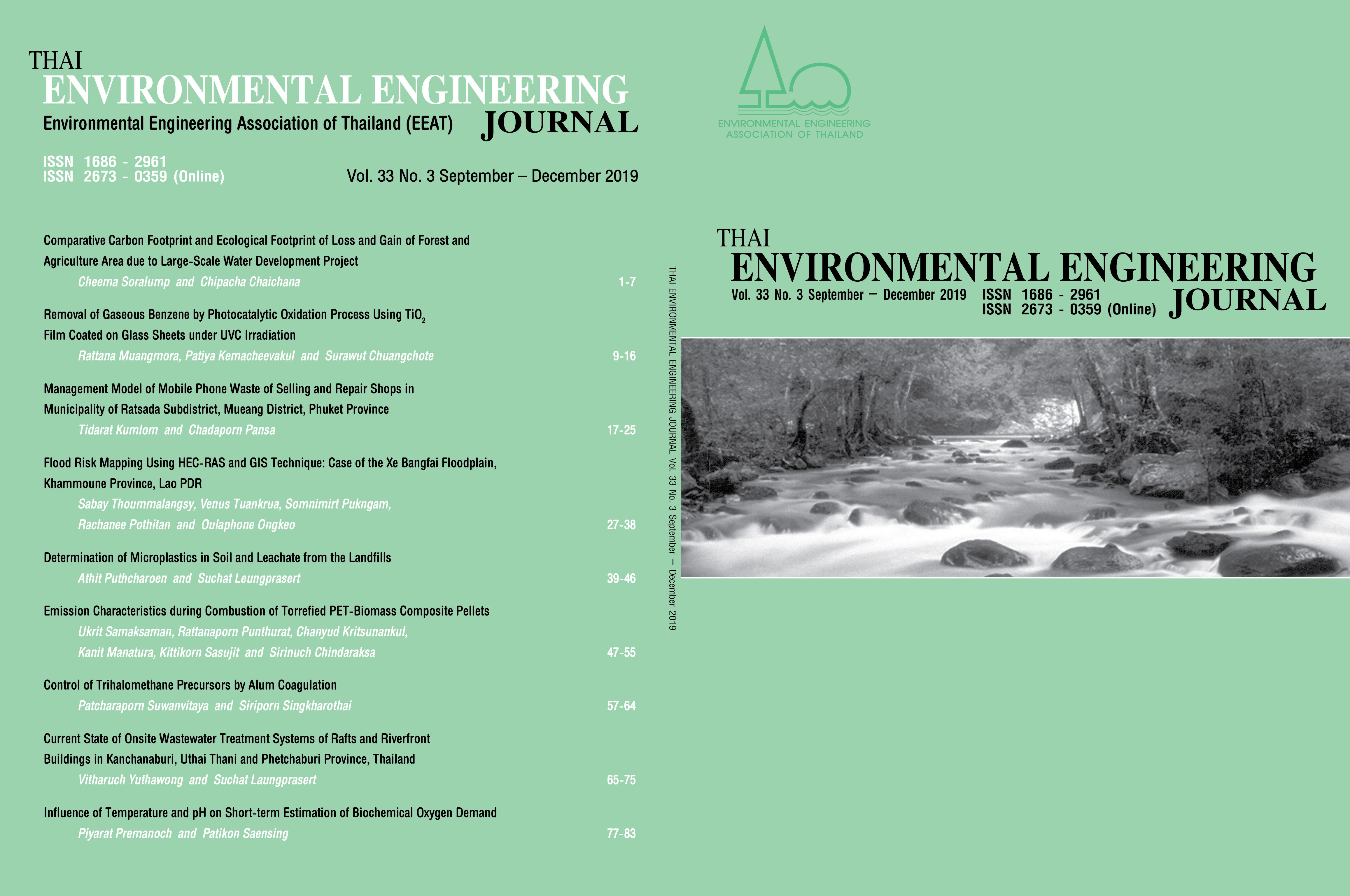Influence of Temperature and pH on Short-term Biochemical Oxygen Demand (BODst) Estimation
Main Article Content
Abstract
This research aims to study the influence of temperature and pH on short-term Biochemical Oxygen Demand (BODst) by measuring an oxygen uptake rate of activated sludge sample (microbe) taken from a return sludge pipe in an oxidation ditch at Maharaj Hospital, Nakhon Ratchasima Province, Thailand. The experiment was conducted by filtering solid materials and aerating sludge for not less than 12 hours without adding any substrates for sludge to enter the endogenous respiration condition. 20 mg/mL (13 mg COD/mL) of sodium acetate was used as a readily biodegradable COD substrate (rbCOD) and dosed to 2.2 liters of sludge sample. Final COD concentration was between 3.0 - 33.9 mg COD/L. Temperature, pH, oxygen and oxygen uptake rate were recorded every 3 seconds using an ultimate hybrid respirometer. Two experimental conditions were conducted, including uncontrolled and controlled conditions. The controlled experiment was conducted at 20, 25 and 30OC (± 0.5 OC) and pH was adjusted to 7.8±0.1 using NaOH 0.05N and HCl 0.05 N, while the uncontrolled experiment was conducted in the range between 25.6-27.6 ° C and pH was adjusted to 7.0-9.6.
The experimental results showed the linear relationship between BODst and COD substrate concentration for each sample of both conditions. The slope of the uncontrolled system was equal to 0.37 (r2 = 0.9917) while for the controlled system, the average slope was equal to 0.31 (r2 = 0.9950). Furthermore, it was also found that when temperature increases, the experimental duration was shorter from 9.7 minutes (20 OC) to 7.0 minutes (30OC) when COD concentration was 5.3 mg/L. Furthermore, the research results showed that temperature does not affect the estimated accuracy of BODst at a temperature range of 20 - 30 OC, which covers increasing temperature of wastewater throughout the year, while pH has a direct effect. Obviously, the findings of this research would be highly beneficial to develop a hybrid respirator system that can be used to analyze BODst of wastewater and effluent in the activated sludge wastewater treatment system for practical operations in plants, which is called the BOD on-line Analyzer.
Article Details
References
[2] Siwiec, T., Kiedrynska, L., Abramowicz, K., Rewicka, A. and Nowak, P. 2001. BOD measuring and modelling methods – review. Land Reclamation. 43 (2): 143–153.
[3] Gernaey, K., Petersen, B., Ottoy, J.P., and Vanrolleghem, P.A. 2001. Activated sludge monitoring with combined respirometric-titrimetric measurement. Wat. Res. 35(5):1,280-1,294.
[4] Guisasola, A. 2005. Modelling biological organic matter and nutrient removal processes from wastewater using respirometric and titrimetric techniques, Ph.D. thesis, Department
d’Enginyeria Quimica, Universitat Autonoma de Bacelona. Spain, 337p.
[5] Saensing, P. and Kanchanatawee, S. 2009. Development of combined ultimate hybrid respirometer-Titrate meter to estimate kinetic parameters of activated sludge. Suranaree J. Sci. Technol. 16(3): 221-233.
[6] Premanoch, P. 2013. Estimation of activated sludge kinetic parameter by using respirometer measurement. Research report. Research and development department. Ramkamhaeng University. Bangkok. 73p.
[7] Premanoch, P. 2015. Estimation of Heterotrophic bacteria coefficient yield by using oxygen uptake rate measurement Ramkamhaeng University journal. No.1. January-June. pp. 48-59.
[8] Premanoch, P. 2516. Influence of Sludge Sample Concentration on Heterotrophic Bacteria Yield Estimation by Using Oxygen Uptake Rate Measurement Method., Research report. Research and development department. Ramkamhaeng University. Bangkok. 34p.
[9] Hoque, M. A. 2010. Development and calibration of bio-kinetic models for organic carbon and nitrogen biodegradation in an aerobic activated sludge system. Ph.D. Thesis, Faculty of Engineering and Serveying, University of Southern Queensland, Australia. 237p.
[10] Gapes, D. and Keller, J. 2001. Analysis of biological wastewater treatment processes using multicomponent gas phase mass balancing. Biotech. Bioeng. 76: 361-375.
[11] Spanjers, H. and Vanrolleghem, P. A. 1995. Respirometry as a tool for rapid characterization of wastewater and activated sludge. Water Sci. Technol. 31 (2): 105-114.
[12] Vanrolleghem, P.A. and Spanjers, H. 1994. Comparison of two respirometric principles for the determination of short-term biochemical oxygen demand. In: Proceedings 49th Purdue Industrial Waste Conference. Lewis Publ., Chelsea, Michigan, 177 – 188.
[13] Henze.M.,Grady, C.P.L.,Gujer, W., Marais, G.V.R., and Matsuo, T. 2000. Activated Sludge model: ASM1, ASM2 andASM3. IWA Scientific and Technical Reports No.9 London: TJ International.
[14] Vanrolleghem, P. A. and Spanjers, H. 1998. A hybrid respirometric method for more reliable assessment of activated sludge model parameters. Water Sci. Technol. 37(12), pp. 237-246.
[15] American Public Health Association (APHA). 1995. Standard Methods for the examination of water and wastewater. (18th ed). APHa-AWWA-WEF. Washington D.C.
[16] Muller, A. W., Wentzel, M. C. and Ekama, G. A. 2004. Experimental determination of the heterotroph anoxic yield in anoxic-aerobic activated sludge systems treating municipal wastewater. Water SA. 30(5): 7-12.


